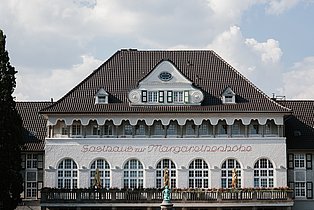
Offers
Regular walks through the settlement and to the Small Studio House and the Model Flat
From the very beginning, Essen's Margarethenhöhe was one of the most important garden suburbs in Europe. As a non-profit foundation of Margarethe Krupp and with the participation of the city of Essen, it was built by the city planner and architect Georg Metzendorf in 29 construction phases from 1909 to 1934/38 during a decisive phase of Essen's urban redevelopment efforts.
In the spirit of the European garden city movement, it was a construction laboratory that lasted almost three decades, in which the tried and tested was constantly refined and new things were tried out. Together with the Siepen valleys surrounding the garden suburb and transformed into forest parks, the Margarethenhöhe offers a quality of life rarely achieved in urban development today.
It served as a housing estate not only for employees of the Krupp company but also for civil servants of the city of Essen. In addition to the spacious and modern flats with sanitary facilities and gardens for the time, Margarethenhöhe also had the social and welfare facilities typical of Krupp housing estates, such as the famous Krupp Konsum, schools, churches for both denominations and a library.
The Ruhr Museum shows the special exhibition "The Margarethenhöhe Garden City" in the small studio house and operates a model flat.
History and art: The permanent exhibition "The Garden City Margarethenhöhe" in the "Kleine Atelierhaus" provides an overview of the unique history of the settlement donated by Margarethe Krupp. In 2020, the exhibition was expanded to include the theme of the artists' settlement with works. In addition, it also tells the story of the artists, who lived in modern apartments and at the same time worked in studios and workrooms on the Margarethenhöhe. The goldsmith Elisabeth Treskow, the bookbinder Frida Schoy, the photographer Albert Renger-Patzsch, the sculptor Will Lammert, the enamel artist Kurt Lewy, the painters Gustav Dahler and Philipp and Hermann Schardt lived next door to the graphic artist Hermann Kätelhön.
Since April 2012, the "Kleine Atelierhaus" has been open to the public thanks to a cooperation with the "Margarethe Krupp-Stiftung" (Margarethe Krupp Foundation).


Modern life: In this museum installation, organized by the Ruhr Museum and the Margarethe Krupp Foundation, you will learn how high the standard of living was on the Margarethenhöhe, which was shaped by the architect Georg Metzendorf.
The model flat shows the carefully coordinated furnishing details using some original Metzendorf furniture as well as detailed replicas.
You can find out how and with what you can best get to us and our locations here.
You can find the next dates at Margarethenhöhe in our calendar.